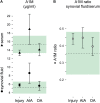α1-Microglobulin Protects Against Bleeding-Induced Oxidative Damage in Knee Arthropathies
- PMID: 30505280
- PMCID: PMC6250851
- DOI: 10.3389/fphys.2018.01596
α1-Microglobulin Protects Against Bleeding-Induced Oxidative Damage in Knee Arthropathies
Abstract
Knee injury increases the risk of developing knee osteoarthritis (OA). Recent evidence suggests involvement of oxidative stress induced by inflammation and bleeding in the joint. This study investigates the role in this process of α1-microglobulin (A1M), a plasma and tissue antioxidant protein with reducing function, and heme- and radical-binding properties. We studied matched knee synovial fluid (sf) and serum (s) samples from 122 subjects (mean age 40 years, 31% females): 10 were knee healthy references, 13 had acute inflammatory arthritis (AIA), 79 knee injury 0-10 years prior to sampling, and 20 knee OA. Using immunoassays, we measured sf-A1M and s-A1M, sf-hemoglobin (sf-Hb), sf-total free heme (sf-Heme), and sf-carbonyl groups (sf-Carbonyl). We explored associations by partial correlation, or linear regression models with adjustments for age, sex and diagnosis, and evaluated diagnostic capacity by area under the receiver operator characteristics curve (AUC). The AIA group had 1.2- to 1.7-fold higher sf-A1M and s-A1M concentrations compared to the other diagnostic groups; other biomarkers showed no between-group differences. sf-A1M and s-A1M were with AUC of 0.76 and 0.78, respectively, diagnostic for AIA. In the injury group, the amount of bleeding in the joint was inversely correlated to time after injury when measured as sf-Heme (r = -0.41, p < 0.001), but not when measured as sf-Hb (r = -0.19, p = 0.098). A similar inverse association with time after injury was noted for sf-A1M (r = -0.30, p = 0.007), but not for s-A1M and sf-Carbonyl. Linear regression models showed that sf-Heme was more strongly associated with sf-A1M and sf-Carbonyl than sf-Hb. Independent of diagnosis, sf-Heme explained 5.7% of the variability in sf-A1M and 3.0% in the variability in sf-Carbonyl, but appeared unrelated to s-A1M. High sf-A1M and low sf-Heme or sf-Hb were independently associated with low sf-Carbonyl. In conclusion, our results demonstrate that independent of disease, Hb and heme within a knee joint correlates with an increased sf-A1M concentration that appears to be protective of oxidative damage, i.e., a reduction in carbonyl groups. High concentrations of A1M in synovial fluid and serum was further diagnostic for AIA.
Keywords: heme; hemoglobin; hemolysis; knee injury; knee osteoarthritis; oxidative stress; synovial fluid; α1-microglobulin.
Figures




Similar articles
-
Human radical scavenger α1-microglobulin protects against hemolysis in vitro and α1-microglobulin knockout mice exhibit a macrocytic anemia phenotype.Free Radic Biol Med. 2021 Jan;162:149-159. doi: 10.1016/j.freeradbiomed.2020.02.018. Epub 2020 Feb 21. Free Radic Biol Med. 2021. PMID: 32092412
-
α1-Microglobulin (A1M) Protects Human Proximal Tubule Epithelial Cells from Heme-Induced Damage In Vitro.Int J Mol Sci. 2020 Aug 13;21(16):5825. doi: 10.3390/ijms21165825. Int J Mol Sci. 2020. PMID: 32823731 Free PMC article.
-
Up-regulation of A1M/α1-microglobulin in skin by heme and reactive oxygen species gives protection from oxidative damage.PLoS One. 2011;6(11):e27505. doi: 10.1371/journal.pone.0027505. Epub 2011 Nov 11. PLoS One. 2011. PMID: 22096585 Free PMC article.
-
Structure, Functions, and Physiological Roles of the Lipocalin α1-Microglobulin (A1M).Front Physiol. 2021 Mar 3;12:645650. doi: 10.3389/fphys.2021.645650. eCollection 2021. Front Physiol. 2021. PMID: 33746781 Free PMC article. Review.
-
A1M, an extravascular tissue cleaning and housekeeping protein.Free Radic Biol Med. 2014 Sep;74:274-82. doi: 10.1016/j.freeradbiomed.2014.06.025. Epub 2014 Jul 14. Free Radic Biol Med. 2014. PMID: 25035076 Review.
Cited by
-
Proteomics identifies novel biomarkers of synovial joint disease in a canine model of mucopolysaccharidosis I.Mol Genet Metab. 2023 Feb;138(2):107371. doi: 10.1016/j.ymgme.2023.107371. Epub 2023 Jan 4. Mol Genet Metab. 2023. PMID: 36709534 Free PMC article.
-
Metabolic Priming as a Tool in Redox and Mitochondrial Theragnostics.Antioxidants (Basel). 2023 May 10;12(5):1072. doi: 10.3390/antiox12051072. Antioxidants (Basel). 2023. PMID: 37237939 Free PMC article. Review.
-
Enhancing diagnostic accuracy for HBV-related cirrhosis progression: predictive modeling using combined Golgi protein 73 and α1-microglobulin for the transition from nondecompensated to decompensated cirrhosis.Eur J Gastroenterol Hepatol. 2025 Aug 1;37(8):961-969. doi: 10.1097/MEG.0000000000002970. Epub 2025 Mar 21. Eur J Gastroenterol Hepatol. 2025. PMID: 40207506 Free PMC article.
References
-
- Anderson U. D., Olsson M. G., Rutardottir S., Centlow M., Kristensen K. H., Isberg P. E., et al. (2011). Fetal hemoglobin and alpha1-microglobulin as first- and early second-trimester predictive biomarkers for preeclampsia. Am. J. Obstet. Gynecol. 204 e1–e5. 10.1016/j.ajog.2011.01.058 - DOI - PubMed
LinkOut - more resources
Full Text Sources

